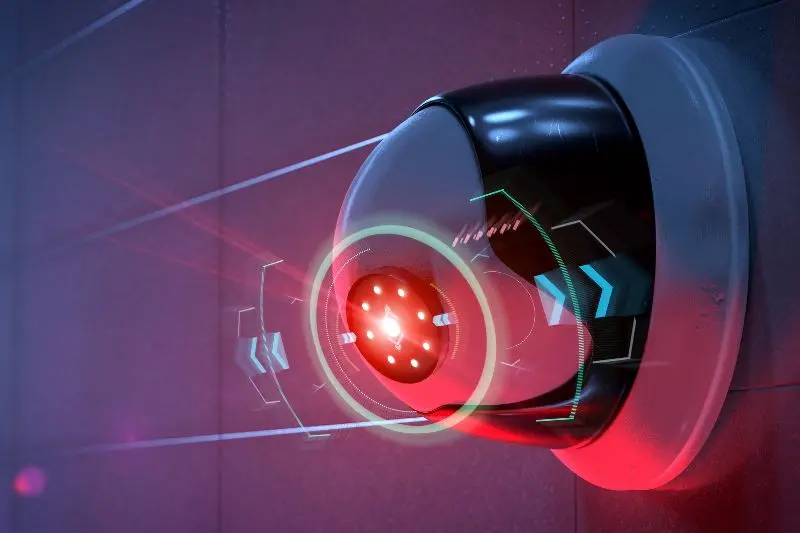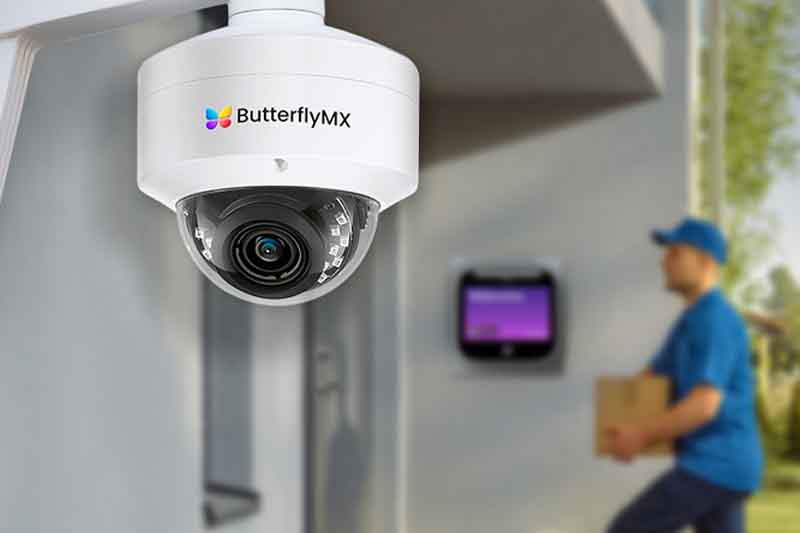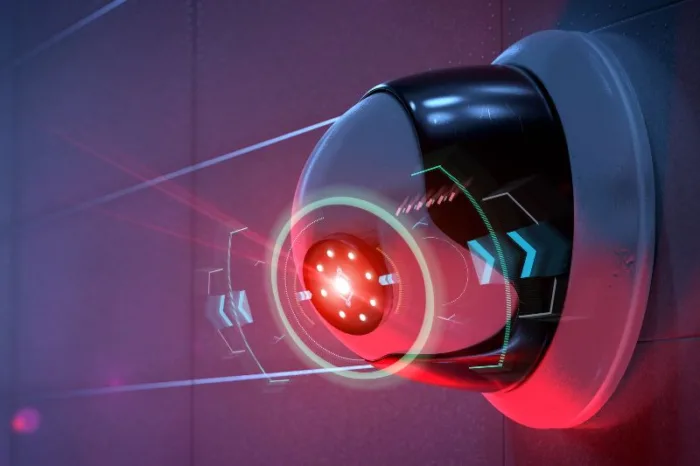Key takeaways
- Indoor security cameras operate by capturing video footage focused on specific areas of your property. This helps you to gain more insights and visibility and help encourage better property decisions.
- Indoor security cameras are designed to provide a clear, real-time view of specific areas inside your home or business.
- Indoor security camera use cases include integration and remote monitoring.

As a property manager or owner, safeguarding your property is your top priority. However, so is increasing the way you gain insight into everyday movement around your building. That’s why indoor commercial security cameras are no longer a luxury but a necessity, providing an extra layer of protection and peace of mind. Whether you’re looking to monitor your property or enhance the security of your business, choosing the right indoor security camera can make all the difference.
As such, this guide will break down how indoor security cameras work. Moreover, we give you a list of the best indoor cameras to increase visibility on your commercial property.
In this post:
- 3 best commercial indoor security cameras
- How do indoor security cameras work?
- Where should you put security cameras indoors?
- Indoor security camera use cases
- Indoor security camera FAQs
3 best commercial indoor security cameras
With so many options available, it can be challenging to select the right indoor security camera for your needs. So, to help you make an informed decision, here’s a detailed look at some of the best indoor security cameras, each offering unique features and benefits.
Best indoor security cameras to buy are:
1. ButterflyMX Security Cameras
Founded in 2014, ButterflyMX has since become a leader in the access control industry and our range of security cameras is equally noteworthy, offering a combination of reliability, advanced technology, and user-friendly features.
What’s more, ButterflyMX’s Bullet and Dome Camera offer the best quality for indoor camera use and will easily increase your ability to gain insights around your building.
Our Security Cameras feature:
- ONVIF compatible. With ButterflyMX, you can pair your existing ONVIF-compatible cameras with our Gateway to connect them to the ButterflyMX OS. Moreover, the ButterflyMX Gateway supports a wide range of ONVIF cameras so that you can manage them remotely from the same dashboard that also manages your other ButterflyMX products.
- 24/7 HD video recording. ButterflyMX Cameras are equipped with high-definition (HD) that capture clear and detailed video footage. Whether you’re looking for more visibility at your building entrance or a more complex area like a hallway, the HD video ensures that every detail is visible.
- Remote access. Lastly, with ButterflyMX, you’re never too far from your building. Our cameras offer robust remote access features, allowing you to view live footage or playback recorded video from virtually anywhere when paired with our OS.
Watch how ButterflyMX works:
2. Cync indoor smart camera
The Cync indoor smart camera by General Electric is an affordable option and might be an easy-to-use security camera without compromising on features.
Features of the Cync indoor smart camera:
- AI-powered motion detection. Unlike traditional motion sensors that may trigger alerts for any movement, the AI function in Cync cameras is designed to differentiate between human activity and other types of motion, such as pets or falling objects. This reduces the likelihood of false alarms, ensuring that you’re only notified when there’s a genuine need for attention.
- Two-way audio. This camera comes equipped with a built-in microphone and speaker, enabling two-way communication. The two-way audio functionality adds an interactive element to your security system, making it more than just a passive monitoring device.
- Night vision. Lastly, the camera’s infrared sensors provide clear, detailed footage even in complete darkness, ensuring that your building is protected. Whether you’re asleep or away, you can rest assured that your camera is capturing everything, even in the dead of night.
3. Eufy Indoor Cam S350
The Eufy Indoor Cam S350 is designed for users who prioritize privacy and security above all else. As such, Eufy is known for its commitment to data protection, making it a possible choice for those who are concerned about their personal information.
Features of Eufy Indoor Cam S35:
- Local storage. Unlike many other security cameras that rely solely on cloud storage, the Eufy Indoor Cam S350 offers robust local storage options. You can store footage directly on a microSD card or a network-attached storage (NAS) device, giving you control over your data. This not only enhances privacy but also ensures that you can access your footage even if your internet connection is down.
- Pan and tilt. The Eufy Indoor Cam S350 is equipped with pan and tilt capabilities, allowing you to adjust the camera’s view remotely. Furthermore, this feature is particularly useful for monitoring larger rooms or spaces with multiple entry points, as it reduces the need for multiple cameras.
- Snapshot feature. Lastly, the snapshot function allows you to create predefined viewpoints within a single room, such as different corners or specific areas of interest. By setting these snapshots, you can quickly switch the camera’s focus between various parts of the room without manually adjusting its position each time.
How do indoor security cameras work?
Indoor security cameras are designed to provide a clear, real-time view of specific areas inside your home or business. As such, indoor security cameras operate by capturing video footage focused on specific areas of your property to gain more insights and visibility and help encourage better property decisions. This footage is processed by a built-in sensor and then transmitted either to a local storage device or a cloud-based service where it can be accessed later.
Here’s a breakdown of the key components that make indoor security cameras work:
- Lens and sensor. The lens captures the visual data, while the sensor converts the light coming through the lens into an electronic signal. Moreover, the quality of the sensor determines the resolution and clarity of the footage. High-end devices, like ButterflyMX’s cameras, will feature advanced sensors that provide crystal-clear images, even in low-light conditions.
- Processor. The processor within the camera plays a crucial role in converting the raw footage captured by the sensor into digital files. These files can then be transmitted over the internet or stored locally. The speed and efficiency of the processor affect the camera’s ability to stream live footage without lag.
- Connectivity. Indoor security cameras typically connect to your home network via WiFi, although some, like the one from ButterflyMX, utilize Power over Ethernet (PoE) connections for more stable, reliable data transmission.
- Storage. Footage can be stored locally on a microSD card or hard drive, or it can be uploaded to a cloud storage service. Overall, cloud-based storage is best because it provides the convenience of accessing footage from anywhere and offers greater storage capacity.
Where to put indoor security cameras
The placement of your indoor security cameras is just as important as the camera you choose for outdoors. What’s more, strategic placement ensures that you capture the most important areas and that the camera’s features are used to their full potential. By carefully selecting the placement of your indoor security cameras, you can ensure comprehensive coverage of your property, reducing blind spots and increasing the effectiveness of your security system.
Here’s a detailed look at where to place your indoor security cameras for optimal coverage:
- Entrances and exits
- Main traffic areas
- Staircases
- Parking garages
- Hallways
- Amenity spaces
- Basements
- Desk areas

Indoor security camera use cases
Indoor security cameras are incredibly versatile and can be used in a variety of scenarios beyond just monitoring for building security.
Here’s a closer look at some of the most common use cases:
- Integration. Indoor cameras can be integrated with smart devices and systems to automate various tasks. For example, they can trigger smart lights to turn on when someone enters a less-used area or adjust the thermostat based on detected activity, enhancing both comfort and energy efficiency.
- Remote monitoring. Cameras allow you to check in on your commercial property remotely. So, whether it’s seeing what visitors are doing, or watching deliverers complete their delivery, indoor cameras provide a convenient way to stay connected.
- Commercial efficiency. In a work setting, indoor cameras can help monitor workflow, ensuring that operations run smoothly. They can be used to observe how spaces are utilized, allowing for better planning and optimization of office layouts.
- Activity tracking. Indoor cameras can also be used to observe and improve daily routines. For instance, you can review footage to identify how certain areas of the property are used, leading to better organization or even helping to establish healthier habits within the household.
Indoor security cameras FAQs
Here are the answers to your most frequently asked questions about indoor security cameras:
- Do indoor security cameras record all the time?
- Do all indoor security cameras need WiFi?
- Is an indoor camera a good idea?
Do indoor security cameras record all the time?
Indoor security cameras can be set to record continuously or only when motion is detected, depending on the settings you choose. So, continuous recording provides comprehensive coverage but requires more storage space and can result in hours of unnecessary footage. For that reason, it’s best to tie entry events throughout your commercial property to your security cameras for easier and faster browsing.
Do all indoor security cameras need WiFi?
While most indoor security cameras rely on WiFi for live streaming and remote access, not all require a constant WiFi connection. Some models offer local storage options that allow the camera to function independently of an internet connection. But cameras with Power over Ethernet connections are more reliable.
Is an indoor camera a good idea?
Yes, an indoor camera is an excellent idea for enhancing visibility around your property. Furthermore, indoor cameras offer numerous benefits, including real-time monitoring and the ability to review footage.

Get your free quote!
Fill in the form below, and we'll email you right back.
Want a free quote?
Fill in the form below, and we'll email you right back.
You’ll be redirected shortly...





